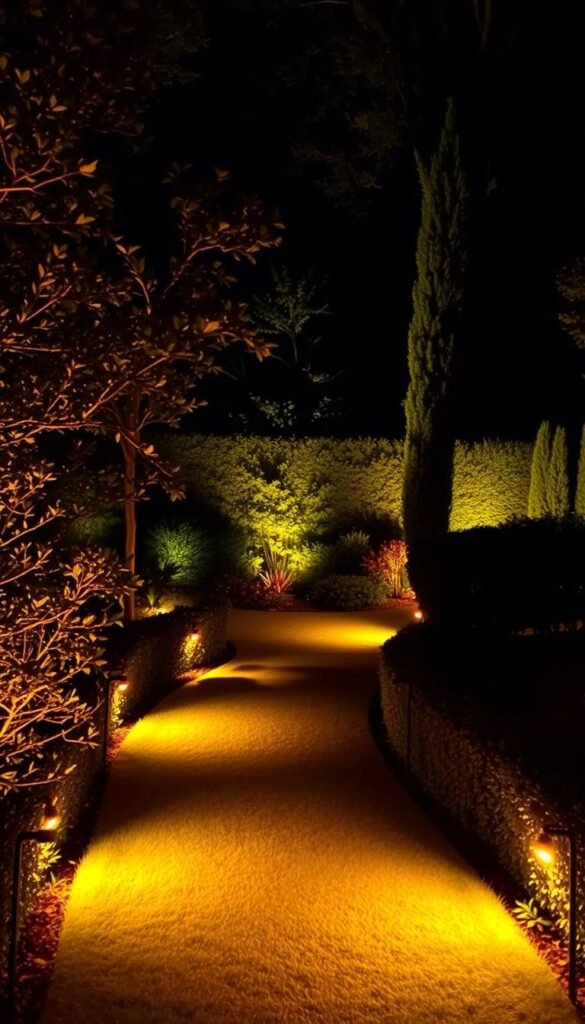When the sun dips below the horizon, your yard doesn’t have to disappear into shadows. Thoughtfully planned illumination can turn ordinary bushes into dramatic silhouettes and make pathways glow like moonlit trails. It’s not just about visibility – it’s about crafting an atmosphere that makes your outdoor area feel like a natural extension of your home.
Modern solutions blend style with practicality. LED bulbs now cost as little as $15, while full professional setups might reach four figures. Whether you’re stringing lights yourself or collaborating with experts, the secret lies in balance. Too much brightness kills the magic, but strategic accents can highlight stonework or make water features sparkle.
Safety matters as much as beauty. Gentle path markers prevent stumbles, while uplighting deters unwanted visitors. Energy-efficient options cut power bills and let you enjoy your sanctuary guilt-free. The best setups make your property feel inviting yet mysterious – like it’s sharing its secrets only after dark.
This guide walks through creating that perfect twilight vibe. You’ll learn how different bulb types affect moods, where to place fixtures for maximum impact, and when to call in design pros. Let’s make your nights outside as memorable as your sunniest afternoons.
Understanding the Basics of Garden Lighting
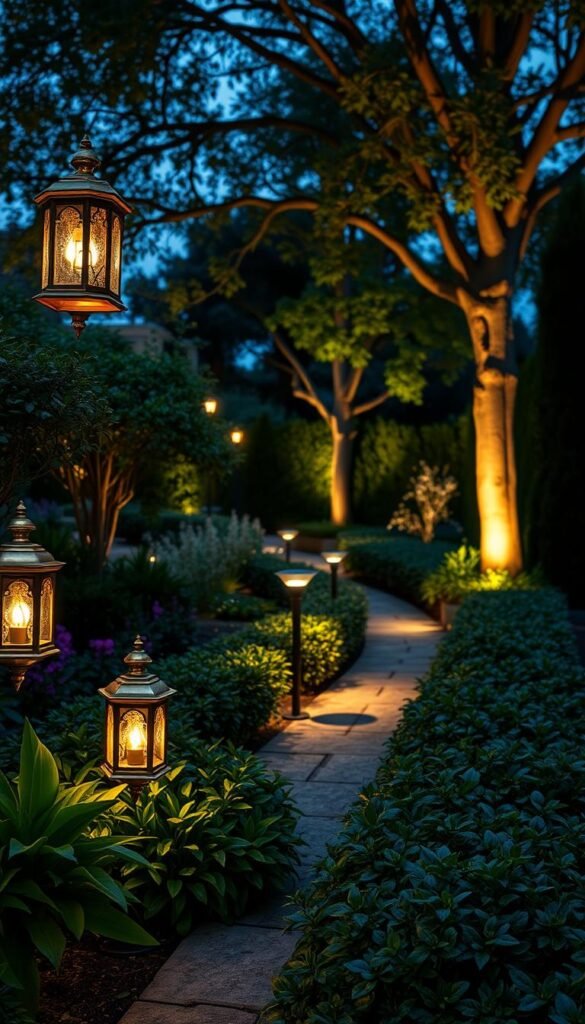
Twilight transforms your yard into a canvas for creative illumination. The right approach combines beauty with practicality, turning functional elements into artistic statements while keeping pathways secure. Start by assessing what you want to achieve – do you need subtle accents or bold drama?
Balancing Beauty With Practical Needs
Your outdoor space should wow guests and prevent stumbles. Use soft path lights spaced 6-8 feet apart – they’ll guide footsteps without blinding eyes. For showstopping moments, try 12-volt systems to spotlight that prized maple tree or stone fountain. These setups use 90% less energy than old 120-volt models, as detailed in this ultimate guide to garden lighting design.
Choosing Tools for the Task
Not all fixtures work the same. Bullet lights sharpen focus on architectural details, while well lights wash walls with gentle glows. Downlights mimic moonlight through branches, creating natural-looking shadows. Pair warm tones (2700K) near seating areas with cooler whites (4000K) along modern walkways.
Remember: lighting isn’t just functional. It’s how you make water features dance after dark or turn ordinary shrubs into silhouette art. Start small – even three well-placed lights can redefine your space.
Planning Your Outdoor Living Space for Nighttime Ambiance
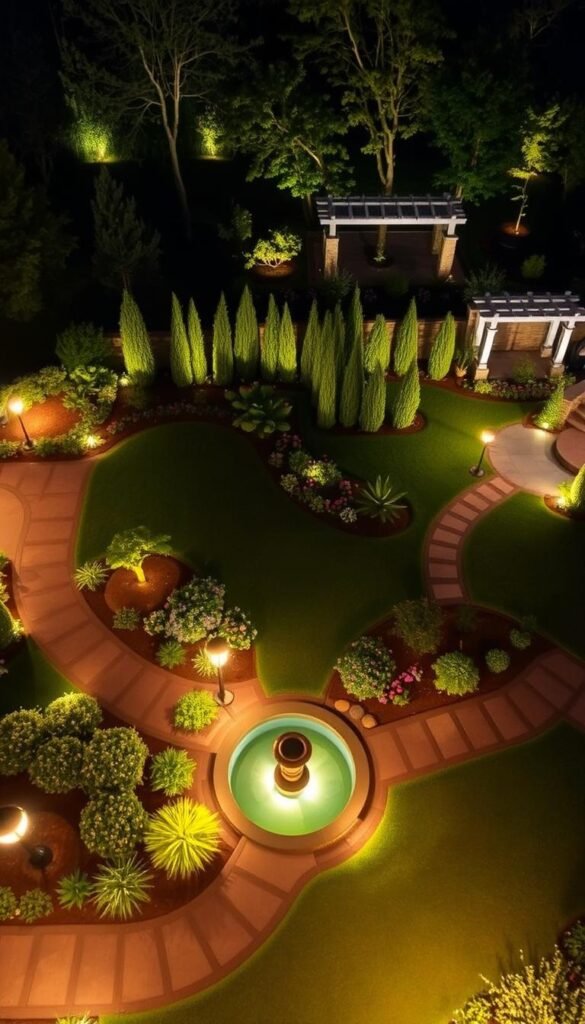
Your backyard becomes a different world after sunset – one where clever illumination turns ordinary corners into inviting retreats. Start by sketching your entire property layout, marking every path, tree, and seating area. This visual guide helps pinpoint where light should whisper and where it should sing.
Mapping Your Garden Layout
Mark Piantedosi of Commonwealth Landscape Lighting suggests a golden rule:
“Space fixtures at least 20 feet apart. You want light pools guiding eyes between plants, not harsh lines.”
This technique creates rhythm in yourlandscape design, making small yards feel larger and large spaces cozier.
Focus on three key areas first:
| Zone | Lighting Effect | Fixture Type |
|---|---|---|
| Pathways | Soft guidance | Low-voltage markers |
| Seating spots | Warm glow | Lantern-style lamps |
| Architectural features | Dramatic emphasis | Adjustable spotlights |
View your plan from windows inside your home – what catches your eye? Maybe that curved walkway or blooming hydrangea. Strategic placement turns these elements into nighttime stars while maintaining safe passage. Your outdoor living space becomes an extension of your indoor comfort, perfect for late-night conversations or quiet reflection.
Essential Lighting Techniques for Enhancing Garden Design at Night
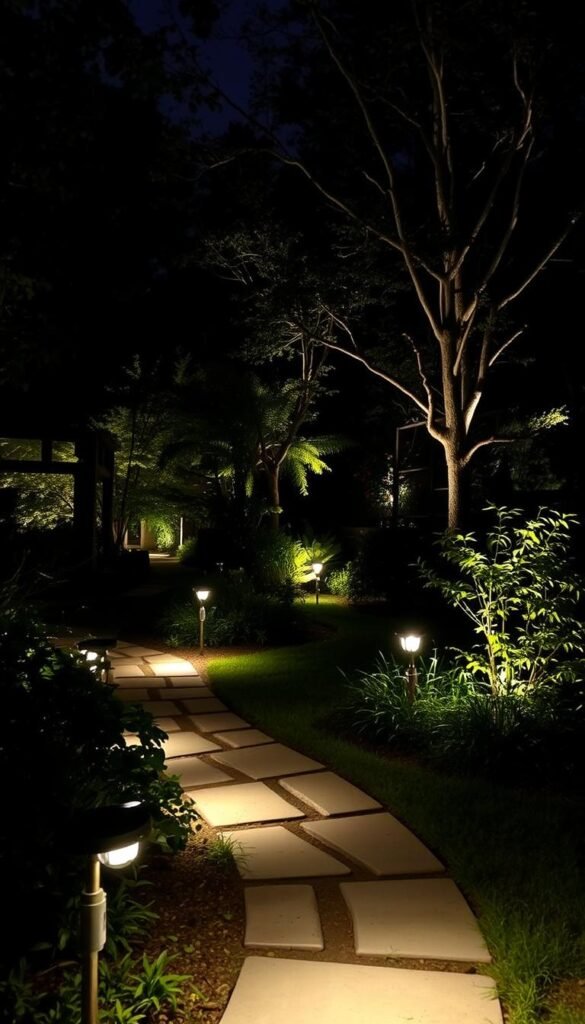
Your garden reveals new dimensions after dark when you apply professional-grade lighting techniques. The secret? Combining artful placement with modern tech to make every leaf and pathway tell a story.
Creating Focal Points and Depth
Transform ordinary trees into living sculptures. For specimens under 20 feet, two 20-watt uplights at the base work magic. Taller giants need 3-5 fixtures (35-50 watts each) to fully reveal their form. Always light both trunks and canopies – this prevents that eerie “floating” effect.
Layer different techniques for 3D impact:
- Uplight stone walls to cast intriguing shadows
- Use downlighting in mature oaks to mimic moonlight
- Frame prized plants with subtle path markers
Architectural features become nighttime stars when washed with warm glows. Try cross-lighting fountains to make water sparkle from multiple angles.
Integrating Smart Lighting Controls
Modern systems adapt to your life while protecting nature. Programmable timers can:
- Shift colors for holiday celebrations
- Dim lights during bird migration months
- Sync with sunset times year-round
Voice-activated systems let you adjust illumination without leaving your patio chair. One Boston homeowner reports:
“My smart setup cut energy use by 40% while making the yard more usable.”
These techniques prove good lighting design isn’t just visible – it’s an experience that evolves with the night.
DIY Installation and Safety Considerations
Installing outdoor lights yourself can feel empowering – until you’re knee-deep in cables. Let’s simplify the process while keeping your project safe and code-compliant. With low-voltage systems operating at 12 volts (stepped down via transformer), you’re working with safer currents than standard home wiring.
Step-by-Step Outdoor Lighting Setup
Begin with a scaled sketch of your yard. Mark existing outlets, trees, and walkways. Position your transformer within 50 feet of a GFCI-protected outlet – this crucial safety feature cuts power during surges. Use 10-gauge wire for main cables to prevent voltage drops over long runs.
Bury lines at least 6 inches deep, avoiding irrigation lines. Stake fixtures firmly, angling them away from windows. Connect lights using waterproof splices – improper seals cause 80% of DIY failures. Test each connection before covering wires.
Practical Tips for Safety and Efficiency
Always wear voltage-rated gloves when handling connections. For complex layouts, consult professional outdoor lighting design services. LED bulbs slash energy use by 75% compared to halogens, while lasting 25 times longer.
Remember: even low-voltage systems need permits in most states. Check local codes for burial depth requirements and fixture spacing. When in doubt, hire an electrician for the transformer hookup – it’s cheaper than fixing fire damage later.
Choosing the Right Bulbs, Colors, and Fixtures
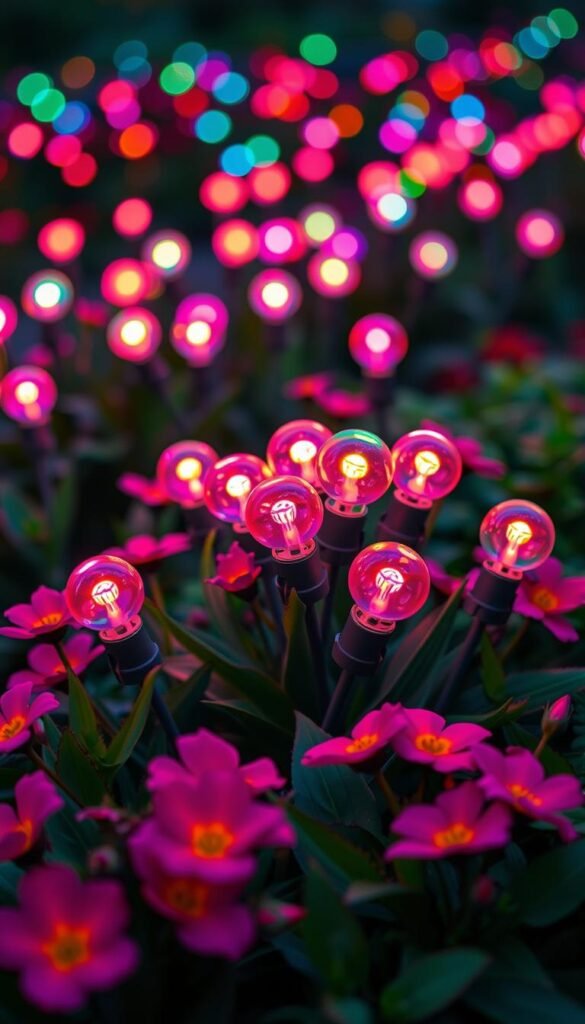
The glow of your nighttime oasis starts with smart selections beyond basic brightness. Your choices influence both mood and maintenance – warm tones invite relaxation, while crisp whites sharpen modern edges. Let’s break down what really matters when picking components for your illuminated paradise.
Warm Hues vs. Cool Light for Ambiance
Color temperature makes or breaks your evening vibe. The International Dark-Sky Association suggests sticking below 3,000K to protect nighttime ecosystems. For cozy seating areas, 2,700K bulbs mimic firelight’s amber glow. Cooler 4,000K options work well along contemporary pathways where clarity matters.
| Bulb Type | Lifespan | Energy Use | Best For |
|---|---|---|---|
| LED | 40,000 hours | 1-11 watts | Frequent use areas |
| Halogen | 2,000 hours | 20-60 watts | Temporary accents |
Fixtures shape how light interacts with your space. Bullet lights carve precise beams through dense foliage, while well lights create subtle uplighting effects. Consider fixture finishes too – bronze blends into natural settings, but polished nickel pops against modern architecture.
Energy Efficiency and Long-Term Benefits
LEDs outlast traditional options by decades, surviving 20+ years with regular use. They sip energy compared to power-hungry halogens, trimming $100+ annually on utility bills. Durable housing materials like marine-grade brass withstand harsh weather, reducing replacement costs.
Smart choices pay off beyond your backyard. Quality installations boost property value by 20% in some markets, according to recent landscaping surveys. You’re not just lighting a path – you’re investing in memories that shine brighter each year.
Enhancing Landscape Features with Advanced Lighting Design
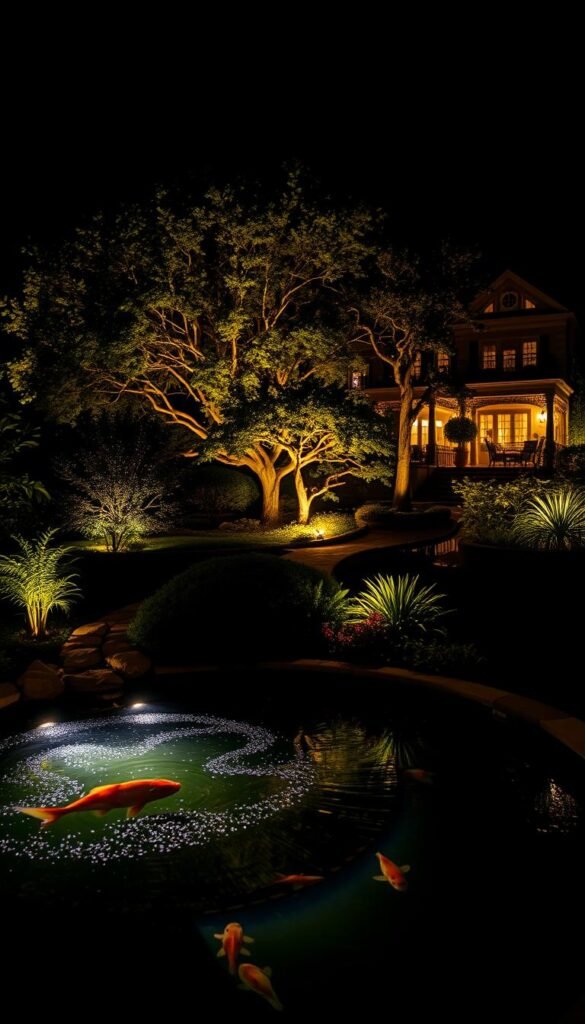
Your outdoor space becomes a nighttime masterpiece when lighting highlights its best assets. By combining technical precision with artistic vision, you can make every curve of your landscape sing after dark. Let’s explore how to amplify both natural beauty and built structures through strategic illumination.
Highlighting Architectural and Natural Elements
Water features transform into liquid jewels with submerged lighting. Waterproof spotlights placed below the surface make ponds shimmer like starry skies. For fountains, position fixtures to catch cascading droplets – the effect rivals fireworks on a small scale.
Guide guests effortlessly with path lights spaced 6-8 feet apart. This rhythm creates visual flow while preventing dark gaps. Choose fixtures no taller than 14 inches to keep focus on your pathways, not the hardware.
Mature trees become living sculptures when lit from below and above. Use 30-watt uplights for trunks and downlights in branches to mimic moonlight. This technique avoids the “floating tree” effect and adds depth to your area.
Architectural details pop with narrow-beam bullet lights. Aim 12-degree spots at stonework corners or pergola beams. Pair them with wide-angle wash lights to softly illuminate larger structures like gazebos. As noted in our guide to elevating your space, layered lighting creates museum-worthy displays.
For retaining walls, install fixtures at both base and cap levels. The interplay of shadows and light turns functional elements into artistic statements. Remember: great lighting design doesn’t shout – it reveals what’s already beautiful.
Wrapping Up Your Nighttime Garden Transformation
As dusk settles, your yard becomes a stage for creativity. With smart fixture choices and layered techniques, you’ve learned to craft spaces that feel both magical and functional. The right balance turns ordinary evenings into memorable experiences where plants whisper stories and path markers become guiding stars.
Your efforts now pay dividends beyond beauty. Energy-efficient bulbs keep costs low while enhancing safety across walkways. Strategic placements highlight architectural details, making your property feel curated yet welcoming. Remember – great design works quietly, letting nature’s shapes take center stage.
Whether hosting friends or enjoying solitude, your transformed outdoor living area extends your home’s comfort. Warm glows invite lingering conversations, while moonlit trees create natural drama. These changes don’t just improve your space – they reimagine how you live after dark.
Now’s the time to experiment. Swap bulb colors with the seasons. Adjust angles to chase shifting shadows. Your garden’s nighttime ambiance evolves as you do, proving thoughtful lighting isn’t a finish line – it’s the beginning of countless enchanted evenings.

